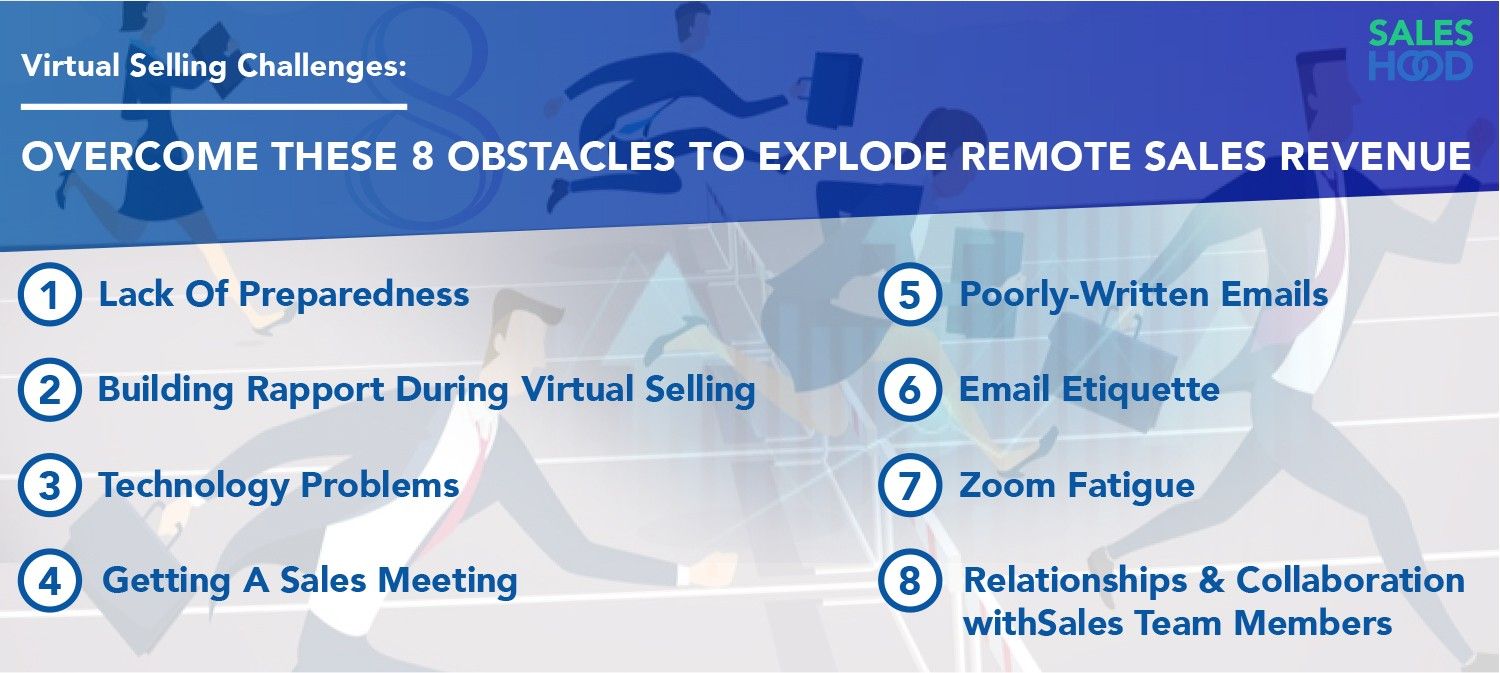The pandemic has left revenue teams scrambling to find a way to sell effectively and overcome the virtual selling challenges of the new virtual-driven economy.
For sellers, this means new challenges, but also – new opportunities.
While the “new normal” has shaken up the sales industry – the SKO must go on!
The good news is that by taking advantage of modern sales tools and the countless virtual platforms and technologies available for sellers, while identifying, adjusting, and leveraging the new requirements for success in virtual sales – sellers can not only survive, but THRIVE, and increase sales revenue.
Company-wide virtual selling is relatively new, so you and your sales teams will face new obstacles, but with 81% of sales professionals now selling through video conferencing, a new set of best practices is emerging.
Read on to learn the top 8 virtual selling obstacles sellers must overcome to Zoom (pun intended) past your sales revenue goals in 2021.

Virtual Selling Challenges
Talented salespeople can still have problems adapting to the new, virtual nature of their work.
Virtual selling isn’t the same as selling face to face.
While the core concepts are the same, you need to account for new and different challenges on how to close virtually and focus on overcoming the challenges below:
1) Lack Of Preparedness
Most of the challenges of virtual sales involve a lack of the preparedness needed to succeed.
These challenges include the technical aspects of building rapport during virtual interactions, but even the most basic aspects of personal interactions are changed during virtual meetings.
- Most salespeople had little or no experience working from home before the pandemic.
- Basic aspects of social interactions are changed during virtual communications. Responsiveness and visual accompaniment are a new challenge you need to deal with.
- Fighting distractions is more difficult virtually. Salespeople must handle new kinds of distractions on both sides of their monitors.
- “Winging it” is not possible for even the best of the best. You lose much of your intuitive abilities interacting through a virtual meeting.
Through research and analysis and preparation companies are actually seeing the sales cycle shorten. Businesses and buyers are feeling more understood and everyone wins.
2) Building Rapport During Virtual Selling
You need to dig for a lot of information to close a sale.
You need to discover prospects’ fears, wants, desires, and get down to what exactly is driving buyers’ decisions.
Virtual sales naturally create an emotional barrier – the ice wall is there and the first thing that it stops is the information you need to do your job.
- It’s an uphill battle to open your customers up. Sellers need to learn how to make prospects more receptive over a virtual meeting environment.
- A lack of receptiveness is natural and if sellers are unable to pick up on the differences between face-to-face meetings and virtual sales conversations a sales rep will struggle.
- Removing ambiguity and getting the answers you need brings a new dynamic to sales.
The only solution to the challenges above is to reframe your line of questions, and that requires new sales skills and practice.
3) Technology Problems
Technical know-how wasn’t normally a serious requirement in the sales industry before but now – you need to know how to use virtual meeting platforms and tools and execute presentations and processes smoothly.
- Before the coronavirus, teleworking was a benefit enjoyed by only 5% of sales professionals. It was an option available to only an elite few.
- Effective technology use is now mandatory for strong virtual sales performance.
You can engage virtual customers and build rapport using a full suite of tools to your advantage but you must master:
- The Art of the Virtual Presentation
- Slideshow Creation
- Presenting Digital Contracts and Acquiring E-signatures
- Automated follow-up with Email and Text Message sequences
- Professional Zoom Backgrounds
- Video and Audio
Representing yourself on a virtual medium introduces a new dynamic to sales. You need to have a strong online presence and learn new technology, techniques, and how to build trust in a new virtual environment.
Many salespeople haven’t been educated on the best ways to stack the odds in their favor in this new technological era. This leads to embarrassing mistakes that would be unthinkable in a traditional sales environment
4) Getting A Sales Meeting
Salespeople who are used to prospecting might not have much of a challenge here, but for many sellers, it’s hard to simply switch to casually “getting in touch”.
Most clients are just busier right now.
The new status quo has made the first hurdle – getting to talk in the first place – different.
As a salesperson, if you want to get your “foot in the door”, you’re going to have to be more creative.
The new tools a modern salesperson needs repertoire include:
- Offering a way to solve customers’ problems and delivering it to them
- Learning to capture decision maker’s attention by phone, SMS, or email
- Understanding effective email communication that gets that foot in the door
- Video Prospecting with sales outreach videos
Sales reps can work magic if you master the art of getting buyers’ attention virtually.
5) Poorly-Written Emails
Having sales meetings virtually requires better communication practices on and off the virtual call.
Emails have always been important, but now they’ve now reached a new level of importance.
That means placing a greater emphasis on research, writing more convincing emails, and closing the meeting before you can start closing the sale.
Getting a meeting in the first place requires you to demonstrate value and persuade via email – not to mention a catchy subject line that will open up opportunities for relationships via cold email.
6) Email Etiquette
Sales professionals need to carry their professionalism with them during meetings and emails.
Email is a critical component of your sales activities.
A lot of the challenges we’ve gone over can be avoided by focusing on the things that make emails more effective.
- Emails that are either too long or too short will demonstrate poor communication skills for sellers.
- Brevity is good, up to a point. But overly long emails shouldn’t be used as emails, but rather as PDF files if they justify that much space.
- Make sure your email address is professional. An email address should end with “@yourcompany.com”. Personal addresses or addresses with silly names won’t be well-received.
- Large blocks of text are hard on the eyes. The people reading your emails should be able to scan through with relative ease.
- Try to make sure each paragraph is able to cover one subject. Avoid run-on sentences or large, ugly blocks.
- Call out individuals by name if you need an answer from them.
- Emails sent to more than one person can get lost in the business of day-to-day life.
- Likewise, don’t CC too many people in your emails or they won’t look specific.
7) Zoom Fatigue
Selling is a hard job, one that can be draining enough on its own. But virtual selling adds a new dynamic to the job that can mentally exhaust even seasoned salespeople.
“Zoom fatigue” is already being studied for its effects on physical and mental health.
The specifics are still being studied but as you probably already know there’s a biological “burnout” associated with the overuse of video conferencing platforms and screentime.
- Managing virtual sales meetings is not the same as managing an in-person conversation. It expends a different kind of mental energy and you need to prepare for that.
- Try to limit intense, close eye contact which comes from staring at your subject with your computer screen too close to your face
- Try to turn off the setting that shows you yourself on the screen – staring yourself for too long apparently is a key factor to Zoom fatigue.
- Take frequent breaks and do eye exercises to let your body relax and reset.
The weight of these new requirements and the unfamiliarity of the new sales shift is draining and requires acknowledgment, preparation and time to reset.
To operate at peak effectiveness consistently you need to stay aware of how draining virtual interactions make you feel and plan accordingly to perform your best.
8) Relationships & Collaboration with Sales Team Members
Working remotely means a sales team has to adapt to virtual relationships with each other.
Adapting to this virtual selling environment is a team effort.
Many teams have never experienced remote teamwork and collaboration, let alone full-time remote selling from a home office.
Enabling sales teams to perform at their best while working remotely requires collaboration skills as well as technology. This challenge requires modern solutions that keep salespeople aligned, allows consistent feedback with their sales team in a meaningful way, and fosters continuous improvement of their sales skills and sales process.
This is where a solid sales enablement program comes into play.
There aren’t any shortcuts to fostering extreme alignment and ensuring accountability, but the Sales enablement platform can help to ensure everyone has access to the resources, collaboration, and feedback they need to obliterate sales goals.
Learn more about Sales Enablement Training from the best in the business.

Virtual Sales Training
Virtual selling is a new experience that brings new challenges and requires new techniques and new sales skills.
But 100% – there’s no reason it should impede your success.
Sales leaders and sales reps can improve their virtual selling skills through new sales training resources.
While virtual selling makes many aspects of sales harder, it’s opened up a new opportunity.
You can get ahead of remote selling and make your video calls much more successful by paying attention to and preparing for the main obstacles of selling in the new work environment.
With time and experience, the “new normal” will shift to just another workday.
Join our Remote Selling Masterclass to enable your sales reps to close better and faster from home. You can request a free demonstration to learn more.



